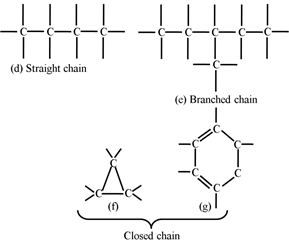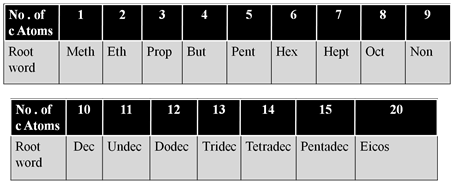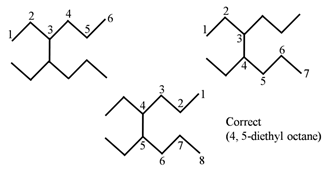Introduction,Modern Definition ,Structural Formulae,Classification,Acyclic and Alicyclic compounds,
- Books Name
- Kaysons Academy Chemistry Book
- Publication
- Kaysons Publication
- Course
- JEE
- Subject
- Chemistry
Introduction To Organic Chemistry
Definition of Organic Chemistry (Historical Background)
Old Concept:- The word ‘organic’ signifies life. Therefore, all substances which were obtained directly or indirectly from living organisms, plants and animals, were called organic compounds and the branch of chemistry which deals with these compounds was called organic chemistry. Although, a large number of organic compounds such as sugar, starch, alcohol, oils, indigo, resins, etc., had been known from earliest times, very little information was known regarding their chemistry until the beginning of the eighteenth century.
In 1675, Lemery published his famous Cours de Chymie, in which he classified the natural substances into three classes according to their respective origin:
(i):- Mineral substances obtained from the mineral kingdom.
(ii):- Vegetable substances obtained from the vegetable kingdom.
(iii):- Animal substances obtained from the animal kingdom.
This classification was accepted quickly but it was Lavoisier (father of chemistry) who first showed, in 1785, that all compounds obtained from vegetables and animal sources always contained carbon and hydrogen, and frequently nitrogen and phosphorus. It was also realized that some organic compounds occurred both in plants and animals. This led to the re-classification of natural substances into two categories.
(i):- All those which could be obtained from vegetables or animals, i.e., the substances which were produced by living organisms. These substances were produced by living organisms. These substances were classified as organic compounds.
(ii):- All those which were not obtained from the living organisms. These substances were classified as inorganic compounds.
Quite a large number of organic compounds have been discovered and isolated from natural sources by the first quarter of the nineteenth century but till then none of the organic compounds could be prepared in the laboratory. This led to belief that organic compounds followed laws of formations different from inorganic compounds. Berzelius assumed that some vital force (life force) was necessary to produce organic compounds and synthesis of these compounds in the laboratory was impossible due to the absence of this vital force which only existed in living organisms.
The vital force theory suffered the first death blow, in 1828, when Wohler synthesised the first organic compound, urea, in the laboratory by heating ammonium cyanate (an inorganic compound).
![]()
Ammonium cyanate is prepared by one of the following methods
![]()
![]()
![]()
A further blow to vital force theory was given by Kolbe, in 1845, when he synthesized acetic acid, the first organic compound, in the laboratory from its elements and later by Berthelot, in 1856, who synthesized methane.
![]()
Ammonium cyanate is prepared by one of the following methods
![]()
![]()
![]()
A further blow to vital force theory was given by Kolbe, in 1845, when he synthesized acetic acid, the first organic compound, in the laboratory from its elements and later by Berthelot, in 1856, who synthesized methane.
![]()
Since then a large number of organic compounds have been synthesised and their formation is governed by simple laws of formation as applicable to inorganic compounds and does not depend on the special vital force.
In spite of the fact that there was no fundamental difference between organic and inorganic compounds but a superficial distinction was maintained between organic and inorganic chemistry and this distinction is still followed.
Modern Definition of Organic Chemistry
Since carbon is an essential constituent of all organic compounds, organic chemistry is defined as the chemistry of carbon compounds. In fact, out of millions of organic compounds now known, there is not a single compound that does not contain carbon. However, there are compounds of carbon such as carbon monoxide, carbon dioxide, metal carbonates and bicarbonates, metal cyanides, metal carbides, etc., which are studied in inorganic chemistry because of their properties.
The simplest organic compounds are those which are composed of carbon and hydrogen only and are called hydrocarbons. Other organic compounds may be regarded as derivatives of hydrocarbons obtained by the replacement of hydrogen by any other element or group. Thus, organic chemistry may also be defined as the chemistry of hydrocarbons and their derivatives.
Reasons for a Large Number of Organic Compounds

(I) Catenation:-
The tendency of an element to form chains of identical atoms is called catenation. This tendency is observed in the case of non-metals showing covalency of two or more. However, this property is maximum in carbon as it can combine with other carbon atoms by single, double or triple covalent bonds. The bonding can be extended to form long open chains (straight or branched) or closed ones.

Catenation property depends upon the value of bond energy which is maximum in the case of carbon.
Bond C –– C Si –– Si S –– S P –– P N ––N O –– O
![]() 83 54 54 50 39 35
83 54 54 50 39 35
The stability or strength of the bond decreases as the bond energy decreases. Hence, the tendency of catenation decreases in the following manner:
C > Si ≈ S > P > N > O
(II) Tendency to combine with other non-metals:-
Carbon has the ability to form strong covalent bonds with many other atoms such as H, O, S, N, Cl, Br, I, etc. The C –– C bond energy is approximately equal to the magnitude of bond energies between carbon and various other atoms,
Bond C –– C C –– H C –– O C –– Cl C –– N C –– Br
![]() 83.0 97.0 86.0 81.0 73.0 68.0
83.0 97.0 86.0 81.0 73.0 68.0
Introduction,Modern Definition ,Structural Formulae,Classification,Acyclic and Alicyclic compounds,
manas was here
Nomenclature
- Books Name
- Kaysons Academy Chemistry Book
- Publication
- Kaysons Publication
- Course
- JEE
- Subject
- Chemistry
Nomenclature
When organic compounds were discovered, the names were assigned by people who discovered it. These names were in general derived from Greek literature or day today usage: example the word Methanol (CH3OH) was derived from Methylic (Greek methu wine and hyle wood; wood alcohol), formic acid (Latin formica ant found in ants). Butyric aldehyde (Latin butyrum butter; found in butter),

Some Common Names

So when the number of iso compounds increased the naming become difficult to understand. In 1958 – IUPAC (International Union of Applied Chemistry) govern made rules that nomenclature rules. IUPAC decides on all matters related to naming of all chemical compounds. (organic, Inorganic Coordination etc).
These rules are updated every few years. The lost update was in 2005-06. Any organic name can be broken into five parts. (animation)
![]()
(1) Root ward
This depends upon the number of carbon atoms is a suitable chain, called the parent Chain.

Ex:- If it is six carbon root war-Hex.
Primary suffix
Is added to indicate saturation or unsaturation in the parent chain.

Secondary Suffix
Indicate the principal functional group. When adding secondary suffix ‘e’ of the prim suffix is removed if – the secondary suffix starts with a vowel or ‘y’ otherwise ‘e’ is retained.
Primary Prefix
Indicate the substance attached to the parent chain. Certain functional groups are never put in suffix always as a prefix. Such as Cloro, Bromo, Iodo, nitro (NO2), alkyl(R), methoxy(OCH3) etc. In the case of cyclic compounds, cyclo become the primary prefix. And other substituent’s go-to secondary prefix. There can be more than are primary prefix.
Secondary prefix
Substitutes in cyclo compounds and Di, Tri etc in others denoting no of substitutes.
Nomenclature rules can be broken into four parts. This makes the process a little easier to understand.
Part A – Saturated and branched alkanes
Part B – Unsaturated compounds and compounds with functional groups.
Part C – Cyclic (only monocyclic)
Part D – Aromatic (only benzene and its derivative)
Nomenclature Rules – Saturated and Branched Chain

1. Select the longest chain (called parent Chain), which may or may not be straightforward to determine the root word. Ex:-1
Nomenclature
Hello

 Kaysons Publication
Kaysons Publication
